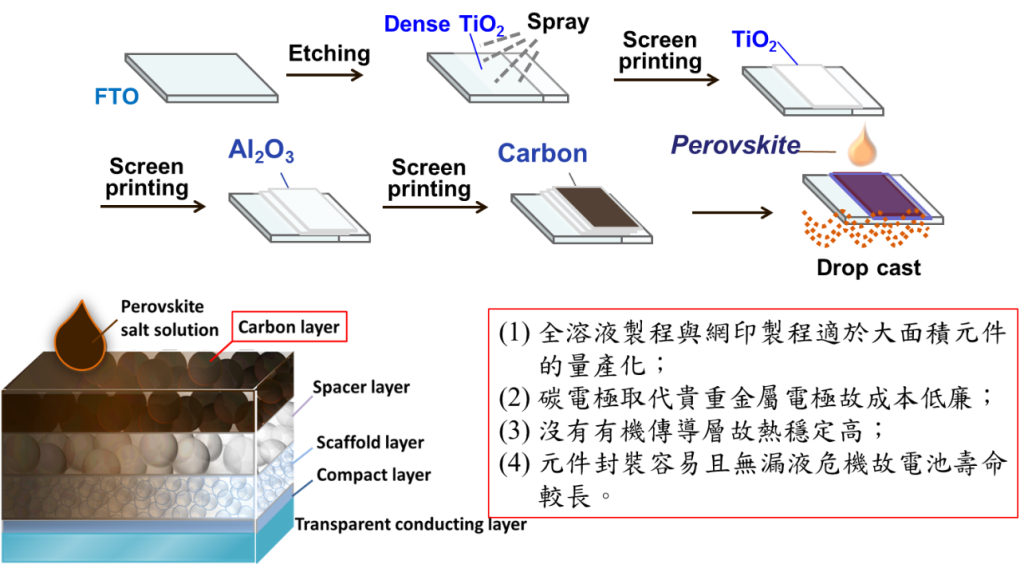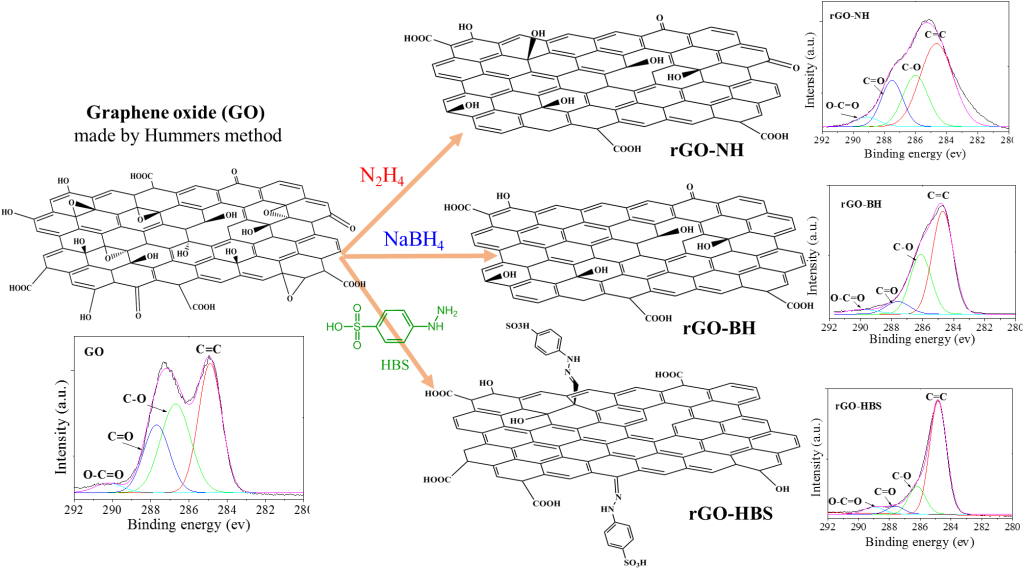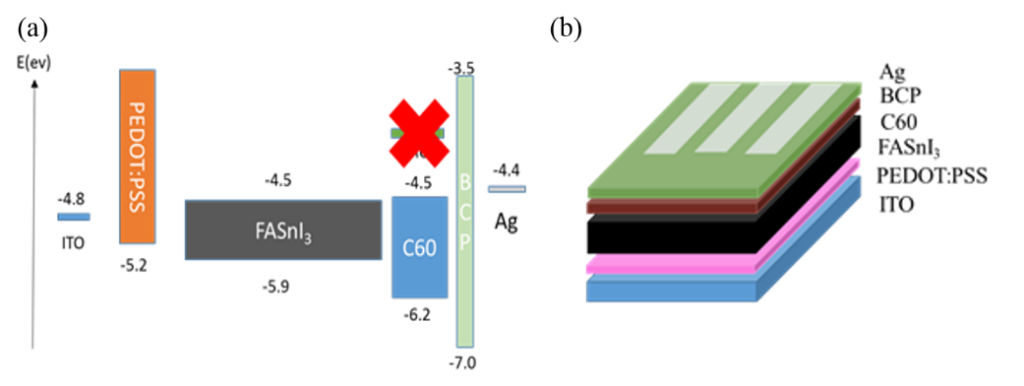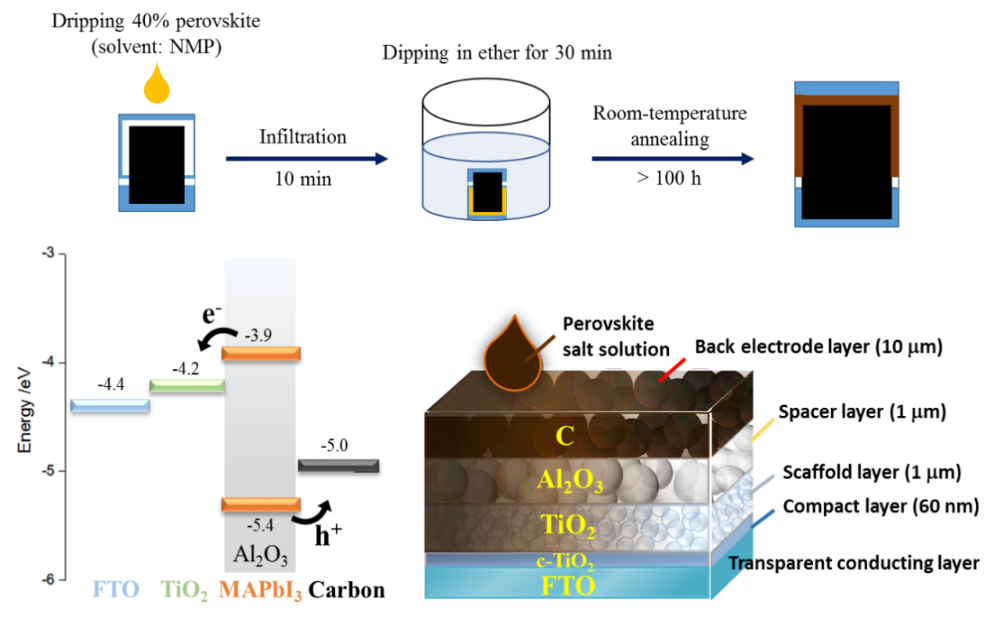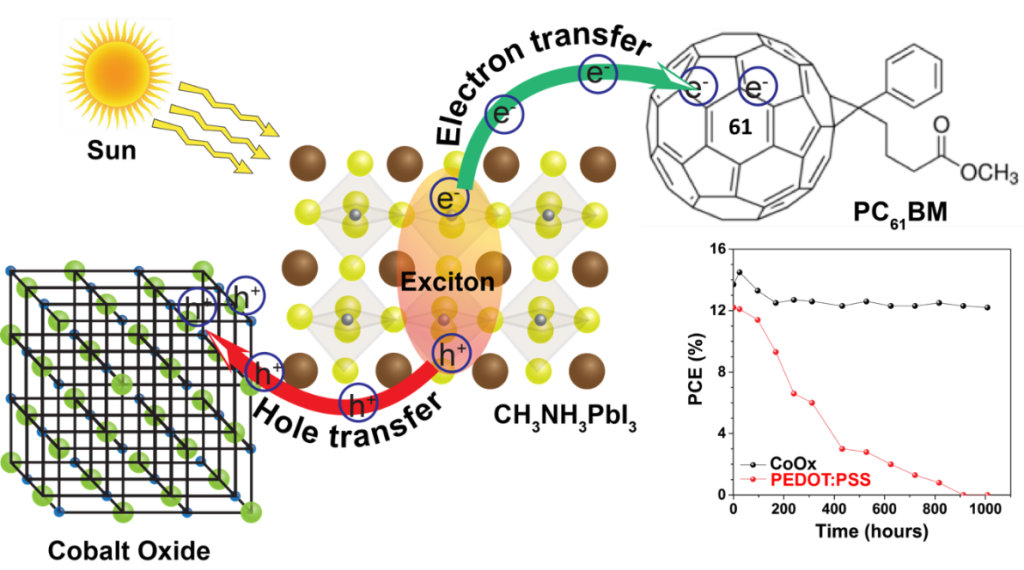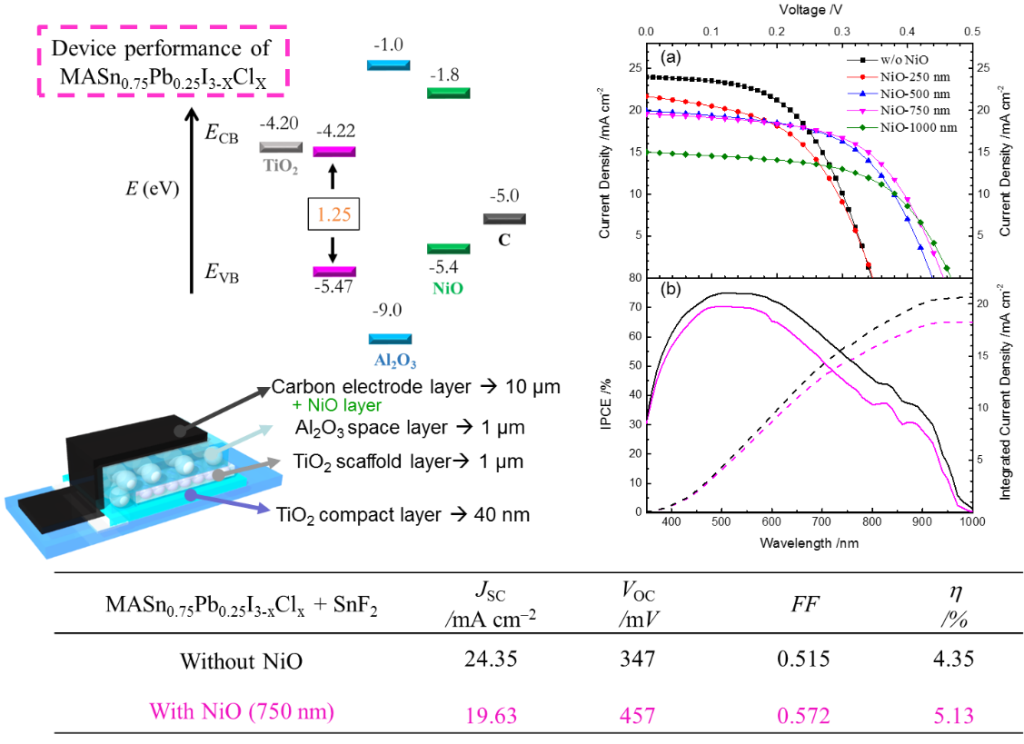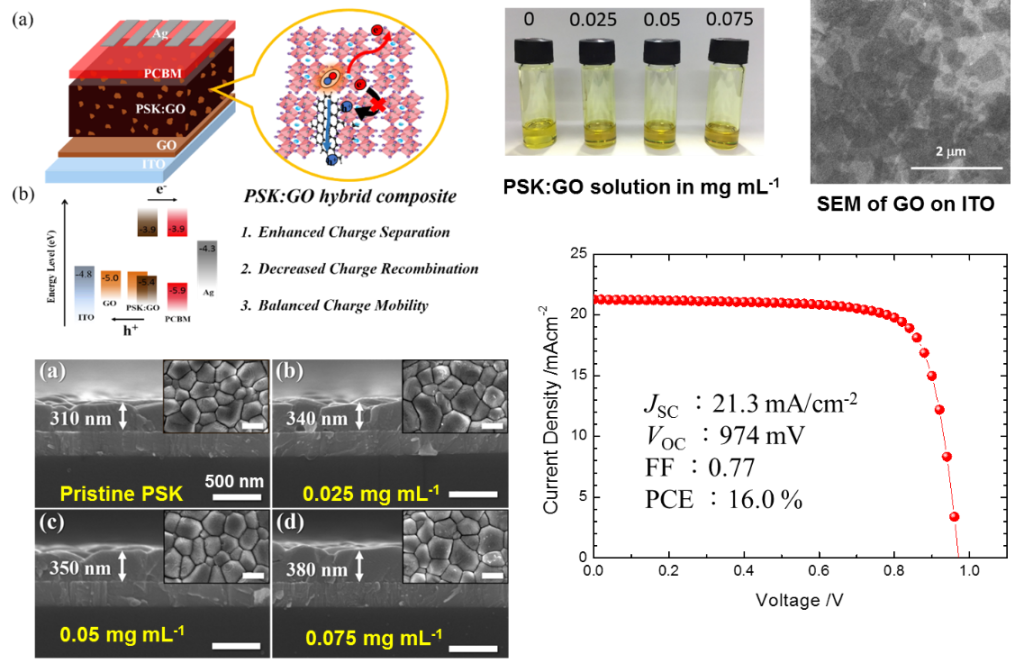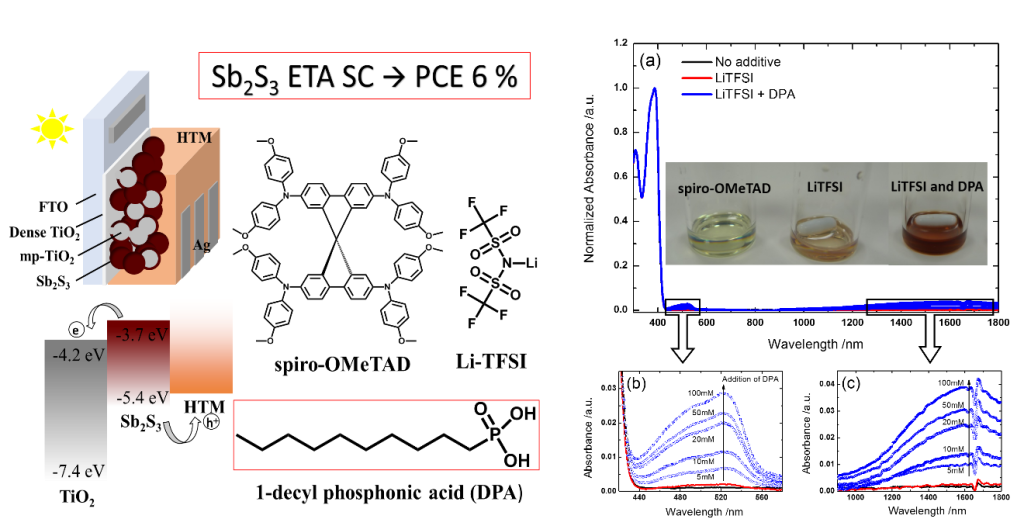研究主題:新世代太陽能電池
人類自工業革命後充分地利用地球的資源,造成了全球暖化這個人類不願面對的事實。
氣候變遷所造成的生態浩劫遍佈全球,這主要肇因傳統火力發電所造成的環境汙染;若能以綠色能源替代石化能源則可大幅減少全球碳排放量,為此各國積極推動國際太陽能聯盟,因此太陽能電池領域的研發對於未來再生能源的貢獻至關重要。
太陽能電池產業目前還是以結晶矽材料所製備的元件與模組為應用大宗,然而矽晶太陽能電池本身就是屬於一個耗能的產業,而且在弱光下的光電轉換效率極差;新一代的太陽能電池例如染料敏化(DSSC)與有機太陽電池(OPV)則效率無法有效提升,因此本實驗室基於之前期執行染料敏化太陽能電池所累積的豐碩經驗與成果,目前專注於新型鈣鈦礦太陽能電池材料與元件之研發。全固態鈣鈦礦太陽能電池自2012年開始發展至今(2017),其光電轉換效率(PCE)即從一開始的10%提升至22%,其在光伏元件的應用上潛力無窮,但鈣鈦礦材料本身尚有一些問題需要解決。
目前所使用的有機無機混成鈣鈦礦材料中,其中心金屬為鉛;而鉛對環境的污染會造成人體產生疾病,因此開發高效能穩定的無鉛鈣鈦礦材料即為鈣鈦礦太陽能電池商業化的當務之急。
因此本實驗室在鈣鈦礦太陽電池方面的研究主題中將致力於發展無鈣鈦礦太陽能電池,我們希望能開發出穩定且高效能之無鉛鈣鈦礦元件為目標;在元件穩定性方面我們希望發展出高效能碳電極鈣鈦礦太陽能電池,並以開發出高效能大面積的碳電極鈣鈦礦電池為目標;另外我們也開發石墨烯電極鈣鈦礦太陽能電池,並希望能開發出高效能大面積的可撓曲鈣鈦礦電池為目標。傳統鈣鈦礦太陽能電池元件結構如下圖所示,不論是n型(n-i-p)或p型(p-i-n)的鈣鈦礦電池,都需使用昂貴的有機電洞或電子傳輸材料,且需蒸鍍金或銀等貴金屬電極,使得製程繁複且設備與材料成本皆大幅提升。
因此在鈣鈦礦電池商業化的進程中,改善元件穩定性與降低製程與材料之成本是其首要目標,也是本實驗室的研究重點。
本實驗室將碳電極應用在鈣鈦礦太陽能電池,在傳統介觀多孔性的元件結構基礎下,我們用碳電極取代了貴金屬電極(Au/Ag),並利用CH3NH3PbI3鈣鈦礦自身優越的電荷傳輸特性取代有機電洞或電子傳輸材料,其元件結構如下圖所示,其電池元件組成為FTO/dense-TiO2/m-TiO2-perovskite/ m-Al2O3-perovskite/Carbon,其中多孔性二氧化鈦(m-TiO2)與碳電極分別為電子與電洞傳輸材料,多孔性二氧化鋯(m-al2O3)則為兩材料間的阻隔層,避免二氧化鈦上的電子和碳電極上的電洞結合。碳電極鈣鈦礦元件的結構簡單、材料成本低廉,其製程又以單一的網印法為主,深具商業化的潛力,但目前參與研究的團隊較少,本實驗室以低溫慢速結晶的方式製作的元件效率最高可達15 %,為目前文獻報導中的最高紀錄,其結果已發表在著名期刊J. Mater. Chem. A。
石墨烯(graphene)由於擁有優異的機械強度、電學性質、光學性質、熱穩定性及低成本等優勢,在相關領域近年都是相當熱門的研究題材,本實驗室以氧化石墨烯(GO)及還原氧化石墨烯(rGO)製備穩定且緻密的薄膜,並搭配其材料能階的匹配性,將其應用於p型(p-i-n)平面異質界面鈣鈦礦太陽能元件上,取代常見的PEDOT:PSS電洞傳輸層。GO的製備利用簡單的溶液相剝離的方式(Hummers method)來合成;rGO的合成則利用三種不同的還原劑,分別是4-肼基苯磺酸(4-hydrazino benzene sulfonic acid/HBS)、聯氨(N2H4/NH)以及氫棚化納(NaBH4/BH),製備出不同還原態氧化石墨烯作為電洞傳輸層;GO與三種rGO的製備示意圖與相關之XPS圖譜如下圖所示。另外由於GO與rGO薄膜的低溫製程優勢,將其沉積於可撓曲導電基材ITO/PEN上,可製作成可撓曲鈣鈦礦太陽能電池元件。本實驗室藉GO與鈣鈦礦混參所製成的元件效能已可達15.2 %;藉rGO電極的表面修飾其元件效能已高達16.4 %,而可撓曲元件效能也已達 13.8 %,動力學研究讓我們進一步了解GO與rGO電極不尋常的電洞擷取行為,其結果分別發表在著名期刊J. Mater. Chem. A 與 Adv. Energy Mater.。
考量鉛汙染對於人體與環境影響,本實驗室積極發展無鉛鈣鈦礦太陽能電池。我們首先利用二氯化錫(SnCl2)前驅物製備混鉛鈣鈦礦應用於碳電極元件中,利用改變不同SnCl2/PbI2比例,我們找到混鉛鈣鈦礦太陽能電池元件的最佳化比例為75/25,在此條件下做成的CH3NH3Sn0.75Pb0.25I3-xClx元件效能可達5.2%,其結果已於2016年發表在ACS Energy Lett.。接著我們利用SnBr2取代混鉛前驅物中的PbI2成功開發出全新結構的全無鉛鈣鈦礦CH3NH3SnIBr2-xClx (MASnIBr2-xClx)並應用於碳電極太陽能電池,並在x = 0.2的條件下(MASnIBr1.8Cl0.2)將此新結構之元件效能提升至3.1%,這是首次發現氯可以和碘與溴同時存在於無鉛鈣鈦礦晶體中的證據,其結果已於2017年發表在著名期刊Angew. Chem. Int. Ed.。此外p-型結構的CH(NH2)2SnI3 (FASnI3)鈣鈦礦太陽能元件(如下圖)光電轉換效率也可達6%以上,具高穩定性的2D結構無鉛鈣鈦礦太陽能電池是我們目前的研究重點之一。
研究成果
A simple drop-casting method via solvent extraction (SECG) was developed to grow dense and uniform perovskite nanocrystals at room temperature for carbon-based mesoscopic solar cells free of an organic hole-transport layer. The CH3NH3PbI3/N-methyl-2-pyrrolidone (NMP) precursor solution (40 %) was first dripped onto a substrate with film configuration TiO2/Al2O3/C and infiltrated at 70°C for 10 min. The perovskite substrate was next immersed in a bath of diethyl ether at 25 °C for 30 min. Third, the solvent-extracted substrate was stored in a dry box (humidity 50 %) at 25 °C for at least 100 h to complete the crystal growth. The device performance attained an efficiency 12.3 % of power conversion (PCE), which is significantly greater than that of DMF (6.3 %) and NMP (8.3 %) devices using traditional thermal annealing. The SECG device displayed a superior intrinsic enduring stability: PCE exceeded 12 % for more than 5000 h. To understand the kinetics of charge transfer and defect relaxation for the devices under investigation, we recorded transient photoluminescence decays at excitation wavelength 635 nm and probe wavelength 770 nm.
Chien-Yi Chan, Yingying Wang, Guan-Wei Wu and
Chien-Yi Chan, Yingying Wang, Guan-Wei Wu and Eric Wei-Guang Diau
Solvent-Extraction Crystal Growth for Highly Efficient Carbon-Based Mesoscopic Perovskite Solar Cells Free of Hole Conductors J. Mater. Chem. A, 2016, 3872-3878
We produced organized mesoporous TiO2 (om-TiO2) layers using a low-cost amphiphilic graft copolymer, poly(vinyl chloride)-graft-poly(oxyethylene methacrylate) (PVC-g-POEM), as a sacrificial template. Perovskite layers were prepared on top of an om-TiO2 layer according to a two-step sequential deposition: after coating the PbI2 solution in dimethyl formamide (DMF) on an om-TiO2 substrate, the substrate was pre-wetted in isopropyl alcohol (IPA) solvent before immersing into a CH3NH3I/IPA solution. This pre-wetting treatment not only improves the yields of conversion from PbI2 to CH3NH3PbI3 but also increases the size of perovskite crystals with cuboid morphology. On varying the pore size and the film thickness of the om-TiO2 layer, the device performance attained 11.9 % of power conversion efficiency (PCE) at pore size 70 nm and film thickness 300 nm. We measured extracted charge densities and decays of transient photovoltage to understand the kinetics of charge recombination in relation to the corresponding device performance.
The devices fabricated according to a simple solution procedure with device configuration ITO/CoOx/CH3NH3PbI3/PCBM/Ag showed the best photovoltaic performance attaining power conversion efficiency (PCE) 14.5 %, which is significantly superior to those fabricated with a traditional HEL such as PEDOT:PSS (12.2 %), NiOx (10.2 %) and CuOx (9.4 %), under the same experimental conditions. Photoluminescence (PL) spectra and the corresponding PL decays for perovskite deposited on varied HEL films were recorded to obtain the hole-extracting characteristics, for which the hole-extracting times show the order CoOx (2.8 ns) < PEDOT:PSS (17.5 ns) < NiOx (22.8 ns) < CuOx (208.5 ns) consistent with the trend of their photovoltaic performances. The reproducibility and enduring stability of those devices were examined to show the outstanding long-term stability of the devices made of metal oxide HEL, for which the CoOx device retained PCE ~ 12 % for over 1000 h.
We synthesized and characterized alloyed Sn-Pb methylammonium mixed-halide perovskites (CH3NH3SnyPb1-yI3-xClx) to extend the light harvesting toward the near infrared region for carbon-based mesoscopic solar cells free of hole-transporting layers. The proportions of Sn in perovskites were well controlled on mixing tin(II) chloride (SnCl2) and lead (II) iodide (PbI2) in varied stoichiometric ratios (y = 0 – 1). SnCl2 plays a key role to modify the lattice structure of perovskite showing anomalous optical and optoelectronic properties: upon increasing the SnCl2 proportion, the variations of band gaps and band energies differed from those made with the SnI2 precursor. The photovoltaic performance was further improved on adding 30 mol % of tin fluoride (SnF2) with device configuration FTO/TiO2/Al2O3/NiO/C producing best power conversion efficiency 5.13 % with great reproducibility and intrinsic stability.
To produce mesoscopic carbon-electrode-based solar cells free of a hole-conduction layer, we developed a simple one-step drop-cast method (temperature 20 °C, relative humidity 50 %) to grow uniform and compact perovskite nanocrystals via slow crystallization (SC). X-ray diffraction (XRD) results indicated that perovskite nanocrystals produced inside the mesoporous TiO2/Al2O3/C layers according to our SC approach with N-methyl-2-pyrrolidone (NMP) as a precursor solvent showed a preferred orientation at facet (004) with large crystalline grains, whereas those produced with other solvents or via thermal annealing (TA) methods showed greater intensity at facet (220) with small crystals. The SC (NMP) device attained the best efficiency of power conversion (PCE), 15.0 %, with average value (13.9 ± 0.5 %), which is much superior to those devices from either the traditional one-step TA (DMF) method (5.2 ± 1.0 %) or the traditional sequential TA method (10.1 ± 0.7 %).
Mixing graphene oxide (GO) with CH3NH3PbI3 (PSK) in varied proportions (0.025, 0.05 and 0.075 mg mL-1) and using GO nanosheets as a p-type electrode for devices with a configuration ITO/GO/PSK:GO/PCBM/Ag produced hybrid composite perovskite solar cells to attain PCE 15.2 % (0.05 mg mL-1), which is greater than a conventional planar heterojunction device (PCE 12.3 %) fabricated using pristine PSK. In the homogeneous PSK:GO active layers, PSK acted as a hole donor and GO as a hole acceptor. The optimum GO concentration (0.05 mg mL-1) produced increased charge mobility, enhanced charge separation and retarded charge recombination, consistent with the trend of corresponding device performances. Our results thus indicate that the hybrid PSK:GO layer increased the interfacial contacts between the donor and acceptor of holes to balance the charge mobility and improved the photovoltaic performance with excellent reproducibility and stability.
Decyl phosphoric acid (DPA) proved an effective p-doping additive to oxidize spiro-OMeTAD as a hole-transporting material (HTM) for nanostructured Sb2S3 extremely thin absorber (ETA) solar cells. DPA had the effect of enhancing the hole conductivities of spiro-OMeTAD in the presence of lithium bis(trifluoromethyl- sulfonyl)-imide (LiTFSI) to improve significantly the device performance. Transient photoelectric measurements and electrochemical impedance spectra of devices fabricated with varied additive conditions provided information about the charge- transport and recombination kinetics and hole conductivities for Sb2S3 devices with additives DPA and LiTFSI that exhibited superior performance. Thirty-five identical devices were fabricated to show the excellent reproducibility and long-term stability in air; the best Sb2S3 ETA device attained efficiency of power conversion 6.0 %, which is twice that of a device using other typical additives (LiTFSI and 4-tert-butyl-pyridine) for spiro-OMeTAD serving as HTM.
We synthesized reduced graphene oxides (rGO) as a hole-extraction layer for high-performance inverted planar heterojunction (PHJ) perovskite solar cells (PSC). The best rGO cells attained PVE exceeding 16 %, much greater than those made of GO and PEDOT:PSS films. A flexible rGO device showed PCE 13.8 % and maintained 70 % of its initial performance over 150 bending cycles. We found that the hole-extraction period is much smaller for the GO/PSK film than for the other rGO/PSK films, which contradicts their device performances. PL and transient photoelectric decays were measured to prove that the reduction of the oxygen-containing groups in GO significantly decreased the ability of hole extraction from PSK to rGO and also retarded the charge recombination at the rGO/PSK interface. When the hole injection from PSK to GO occurred rapidly, hole propagation from GO to the ITO substrate became a bottleneck to overcome, which led to a rapid charge recombination that decreased the performance of the GO device relative to the rGO device.
We synthesized and characterized methylammonium (MA) mixed tri-halide tin perovskites (MASnIBr2-xClx) for carbon-based mesoscopic solar cells free of lead and hole-transporting layers. Varied SnCl2/SnBr2 ratios yielded tin perovskites with three halides (I, Br and Cl) co-crystallized inside the tin-perovskite crystals according to the stoichiometric ratios of the precursors for x ≤ 0.5. A device with MASnIBr1.8Cl0.2 (SnCl2 = 10 %) showed the best photovoltaic performance: JSC = 14.0 mA cm-2, VOC = 380 mV, FF = 0.573 and PCE = 3.1 %, with great reproducibility and long-term stability. Electrochemical impedance spectra (EIS) were recorded to show the trend of device performance of this series with superior charge recombination and dielectric relaxation properties for the MASnIBr1.8Cl0.2 cell. Transient PL decays showed the intrinsic problem of tin-based perovskites with average lifetimes less than 100 ps; the MASnIBr1.8Cl0.2 film featured the greatest lifetime to account for its superior device performance.
The cross-linkable [6, 6]-phenyl-C61-butyric styryl dendron ester (C-PCBSD) was produced via thermal treatment at 160 °C for 20 min while the cross-linkable [6, 6]-phenyl-C61-butyric oxetane dendron ester (C-PCBOD) was obtained via UV-curing treatment for 45 s. The fullerene derivative layer between the ETL and perovskite layers significantly improved electron extraction and suppressed charge recombination on decreasing the density of traps at the ETL surface. A planar PSC with the configuration ITO/TiO2(Au)/C-PCBOD/perovskite/Spiro-OMeTAD/Au attained PCE 15.9 %. The device performance was optimized with C-PCBOD as an interfacial mediate to modify the surface of the mesoporous-TiO2 ETL; the C-PCBOD treated device attained a significantly enhanced performance, PCE 18.3 %. Electrochemical-impedance spectral (EIS) and photoluminescence (PL) decay measurements were carried out to understand the characteristics of electron transfer and charge recombination of the perovskite/TiO2 samples with and without a fullerene interfacial layer.

